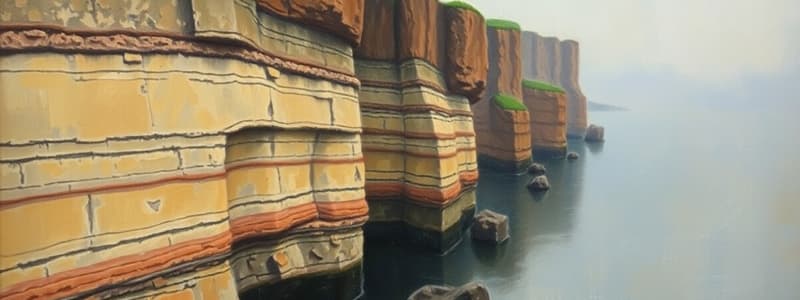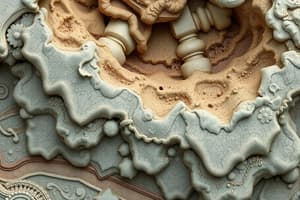Podcast
Questions and Answers
What process occurs when magma cools and crystallizes into igneous rock?
What process occurs when magma cools and crystallizes into igneous rock?
What is a primary effect of volcanic eruptions on the environment?
What is a primary effect of volcanic eruptions on the environment?
Which type of plate boundary is primarily responsible for forming large mountain ranges?
Which type of plate boundary is primarily responsible for forming large mountain ranges?
What is one outcome of processes associated with erosion and deposition?
What is one outcome of processes associated with erosion and deposition?
Signup and view all the answers
Which boundary type is associated with the subduction of oceanic plates beneath continental plates?
Which boundary type is associated with the subduction of oceanic plates beneath continental plates?
Signup and view all the answers
What is the process of breaking down and corroding solid rocks into sediments called?
What is the process of breaking down and corroding solid rocks into sediments called?
Signup and view all the answers
Which type of weathering involves chemical reactions that break down rocks?
Which type of weathering involves chemical reactions that break down rocks?
Signup and view all the answers
What force primarily causes coastal erosion?
What force primarily causes coastal erosion?
Signup and view all the answers
What is the name of the theory proposed by Alfred Wegener regarding continental movement?
What is the name of the theory proposed by Alfred Wegener regarding continental movement?
Signup and view all the answers
Which layer of the Earth is described as plastic and partially molten beneath the lithosphere?
Which layer of the Earth is described as plastic and partially molten beneath the lithosphere?
Signup and view all the answers
In which type of fault does the block above the fault move downward relative to the block below?
In which type of fault does the block above the fault move downward relative to the block below?
Signup and view all the answers
What is the name for the convex upward fold of rock layers with the oldest rocks at its core?
What is the name for the convex upward fold of rock layers with the oldest rocks at its core?
Signup and view all the answers
What components are found in magma?
What components are found in magma?
Signup and view all the answers
Study Notes
Weathering and Erosion
- Weathering: The process of breaking down and corroding solid rocks into sediments.
-
Types of Weathering:
- Physical (Mechanical): Breakdown without chemical change (e.g., freeze-thaw, thermal expansion).
- Chemical: Breakdown through chemical reactions (e.g., oxidation, hydrolysis, carbonation).
-
Examples of Chemical Weathering:
- Dissolution: Minerals dissolve in water.
- Oxidation: Minerals react with oxygen, forming oxides (e.g., rust).
- Hydration: Minerals absorb water, causing expansion and weakening.
- Erosion: The process of moving sediments from one place to another.
-
Main Forces of Erosion:
- Water: Rivers, rainfall, surface runoff.
- Wind: Formation of sand dunes.
- Ice: Glaciers and ice sheets.
- Coastal: Waves and tides.
Earth's Layers and Plate Tectonics
-
Earth's Layers:
- Inner Core: Solid sphere of iron and nickel.
- Continental Crust: ~35-70 km thick.
- Lithosphere: ~100 km thick; crust and uppermost mantle.
- Asthenosphere: Plastic, partially molten layer beneath the lithosphere.
-
Plate Tectonics:
- Continental Drift (Wegener): Continents were once a single landmass (Pangaea) and have drifted apart.
- Seafloor Spreading (Hess): Creation of new oceanic crust at mid-ocean ridges, separating plates.
-
Key Concepts in Plate Tectonics:
- Mid-Ocean Ridges: Formed by seafloor spreading.
- Geomagnetic Reversals: Occur every ~200,000-300,000 years (last major was Matuyama-Brunhes).
Folding and Faulting
-
Folding:
- Anticline: Convex upward fold (oldest rocks at core).
- Syncline: Concave upward fold (youngest rocks at core).
- Monocline: Step-like fold in rock strata.
- Plunging Fold: Fold with a non-horizontal axis.
-
Faulting:
- Normal Fault: Upper block moves down relative to lower block.
- Reverse Fault: Upper block moves up relative to lower block.
- Strike-Slip Fault: Horizontal sliding of rock blocks.
Volcanism and Magmatism
-
Magma and Magma Chambers:
- Magma: Gases, minerals, and liquid rock.
- Magma Chamber: Stores magma before volcanic eruptions.
- Solidification: Magma cools and crystallizes into igneous rock.
-
Volcanic Activity:
- Importance: Provides insights into volcanic activity and crust formation.
- Environmental Effects: Significant landscape alterations and climate impacts.
Geological Processes and Landforms
-
Erosion and Deposition:
- Deposition: Builds up sediment layers, forming new landforms.
- Landform Formation: Trenches from plate interactions (e.g., subduction).
-
Plate Boundaries:
- Transform Boundaries: Earthquakes from stress buildup as plates grind.
- Continental-Continental Boundaries: Large mountain ranges from crust crumpling.
- Oceanic-Continental Boundaries: Oceanic plate subducts beneath continental plate.
- Divergent Boundaries: Seafloor spreading, new oceanic crust creation.
Essay Topics
- Erosion and Weathering: Explains surface shaping, predicts changes, manages resources.
- Fossils and Earth's History: Insights into past life, environments, and evolutionary processes.
- Volcanic Eruptions and Environment: Immediate and long-term climate changes, ecosystem and human impacts.
Studying That Suits You
Use AI to generate personalized quizzes and flashcards to suit your learning preferences.
Description
Explore the concepts of weathering and erosion, including their types and processes. Learn about Earth's layers and the fundamentals of plate tectonics, including the forces that shape our planet. This quiz will test your knowledge of geological processes and Earth's structure.



